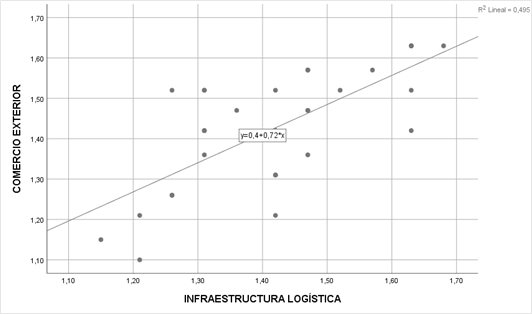Proposal to improve the logistics infrastructure of the Iñapari-Madre de Dios customs border control post and its effects on foreign trade 2013-2017
DOI:
https://doi.org/10.51252/race.v2i2.622Keywords:
customs administration, trade, free economy, customs operationsAbstract
To increase Peru's economic competitiveness, it is essential to streamline and secure international commercial operations, eliminating obstacles in ports, airports and terminals, and facilitating access to key information for foreign trade users. This research proposes to determine to what extent the logistics infrastructure impacts the development of foreign trade at the Iñapari-Madre de Dios customs border checkpoint. To this end, non-experimental descriptive research at a correlational level was undertaken, where the processes related to foreign trade operations were analyzed through a survey of 34 jobs at the border control post. The results reveal a positive and significant impact of the quality of infrastructure, logistics operability and administrative processes with foreign trade according to the Pearson correlation of 0.840, 0.864 and 0.946 respectively. It concludes by affirming the importance of investing in infrastructure, trained personnel and adequate technology to guarantee more efficient foreign trade and reduce the commission of customs crimes.
Downloads
References
Alvarado, A. (2019). Análisis exploratorio de la apertura comercial del Ecuador frente a Perú y Colombia. Revista Economía y Política, 15(29), 9–24. https://doi.org/10.25097/rep.n29.2019.01
Álvarez Torres, C. (2019). Comité de Integración y Desarrollo Fronterizo Perú-Chile: aproximaciones al mundo social y empresarial en torno a la frontera. Si Somos Americanos, 19(2), 49–67. https://doi.org/10.4067/S0719-09482019000200049
Arvin, M. B., Pradhan, R. P., & Nair, M. (2021). Uncovering interlinks among ICT connectivity and penetration, trade openness, foreign direct investment, and economic growth: The case of the G-20 countries. Telematics and Informatics, 60, 101567. https://doi.org/10.1016/j.tele.2021.101567
Bottasso, A., Conti, M., de Sa Porto, P. C., Ferrari, C., & Tei, A. (2018). Port infrastructures and trade: Empirical evidence from Brazil. Transportation Research Part A: Policy and Practice, 107, 126–139. https://doi.org/10.1016/j.tra.2017.11.013
Cao, L. (2020). Changing Port Governance Model: Port Spatial Structure and Trade Efficiency. Journal of Coastal Research, 95(sp1), 963. https://doi.org/10.2112/SI95-187.1
Chen, S., Zhang, H., & Wang, S. (2022). Trade openness, economic growth, and energy intensity in China. Technological Forecasting and Social Change, 179, 121608. https://doi.org/10.1016/j.techfore.2022.121608
Duodu, E., & Baidoo, S. T. (2020). How does quality of institutions affect the impact of trade openness on economic growth of Ghana? Cogent Economics & Finance, 8(1), 1812258. https://doi.org/10.1080/23322039.2020.1812258
Espinoza-Paucar, O. N. (2022). El empoderamiento administrativo para el fortalecimiento de la gestión aduanera del comercio exterior. CIENCIAMATRIA, 8(3), 459–479. https://doi.org/10.35381/cm.v8i3.780
Guadalupe Báscones, J. (2021). COVID-19, comercio exterior peruano y lecciones por aprender. Forseti: Revista de Derecho, 9(13), 6–20. https://doi.org/10.21678/forseti.v9i13.1477
Guerrero Molina, M. I., & Vásquez Suárez, Y. A. (2020). Características de la logística y la infraestructura de Puerto Antioquia en las exportaciones antioqueñas. Revista En-Contexto, 8(13), 169–193. https://doi.org/10.53995/23463279.717
Gutiérrez-Ortiz, A., Méndez-González, C., & Infante-Jiménez, Z. T. (2023). Desempeño logístico, infraestructura portuaria y conectividad marítima en el Continente Americano: un modelo panel dinámico. Revista Amazónica de Ciencias Económicas, 2(2), e526. https://doi.org/10.51252/race.v2i2.526
Ibrahim, K. H., Handoyo, R. D., Wasiaturrahma, W., & Sarmidi, T. (2022). Services trade and infrastructure development: Evidence from African countries. Cogent Economics & Finance, 10(1). https://doi.org/10.1080/23322039.2022.2143147
Liu, M. (2020). Research on Port Infrastructure, Port Efficiency and Urban Trade Development. Journal of Coastal Research, 115(sp1), 220–2022. https://doi.org/10.2112/JCR-SI115-069.1
Mańkowska, M., Kotowska, I., & Pluciński, M. (2020). Seaports as Nodal Points of Circular Supply Chains: Opportunities and Challenges for Secondary Ports. Sustainability, 12(9), 3926. https://doi.org/10.3390/su12093926
Montes Ninaquispe, J. C., & Pantaleón Santa María, A. (2022). Dinámica del intercambio comercial a 12 años del Tratado de Libre Comercio Perú-USA. Revista de Análisis Económico y Financiero, 5(1), 21–25. https://doi.org/10.24265/raef.2022.v5n1.48
Shpak, N., Melnyk, O., Adamiv, M., & Sroka, W. (2020). Modern Trends of Customs Administrations Formation: Best European Practices and a Unified Structure. NISPAcee Journal of Public Administration and Policy, 13(1), 189–211. https://doi.org/10.2478/nispa-2020-0008
Vorotyntseva, T., Nemirova, G., & Vinichenko, A. (2020). Problems of Application of Digital Technologies in International Trade. Proceedings of the “New Silk Road: Business Cooperation and Prospective of Economic Development” (NSRBCPED 2019). https://doi.org/10.2991/aebmr.k.200324.085
Wessel, J. (2019). Evaluating the transport-mode-specific trade effects of different transport infrastructure types. Transport Policy, 78, 42–57. https://doi.org/10.1016/j.tranpol.2019.04.002
Yang, G., Huang, X., Huang, J., & Chen, H. (2020). Assessment of the effects of infrastructure investment under the belt and road initiative. China Economic Review, 60, 101418. https://doi.org/10.1016/j.chieco.2020.101418

Published
How to Cite
Issue
Section
License
Copyright (c) 2023 Fredy Barrantes-Olarte

This work is licensed under a Creative Commons Attribution 4.0 International License.




